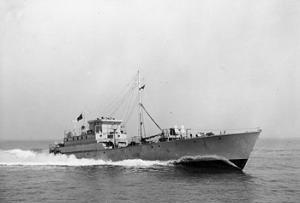Operation Bridford
 |
|
| History | |
|---|---|
|
|
|
| Name: | HMS Gay Viking |
| Builder: | Camper & Nicholson |
| Fate: |
|
| General characteristics | |
| Class and type: | MGB 502 Motor Gun Boat |
| Displacement: | 95 long tons (97 t) |
| Length: | 117 ft (36 m) |
| Beam: | 20 ft 3 in (6.17 m) |
| Draught: | 4 ft 1 in (1.24 m) |
| Propulsion: |
|
| Speed: | |
| Range: | 2,000 nautical miles (3,700 km) at 11 kn (20 km/h) |
| Complement: | 21 |
| Armament: |
|
HMS Gay Viking was a Motor Gun Boat of the Royal Navy, serving with Coastal Forces during the Second World War. Gay Viking was one of eight vessels that were ordered by the Turkish Navy, but were taken over by the Royal Navy during the Second World War to serve as a flotilla of blockade runners. Designated as Gun Boat 506 but sailing under the name Gay Viking she operated out of Hull on two separate operations to the Scandinavian countries. She was one of the more successful of her group, but was lost in a collision while returning from one of these operations. Reports indicate that she may have been salvaged after this and gone on to sail for a considerable number of years as a civilian vessel.
Gay Viking was built by Camper and Nicholson as part of an order of eight Motor Gun Boats placed by the Turkish Navy. She was launched in February 1941 but the outbreak of the Second World War led to the Royal Navy taking over the eight vessels giving them numbers (502-509). The Navy then completed them to take part in Operation Bridford.
The objective of Operation Bridford was to bring back to Britain quantities of ball bearings manufactured by Sweden's SKF. To do this, the vessels would have to reach Sweden by evading the German blockade of the Skagerrak. Once there, the vessels would load the ball bearings and return to Britain. British engineering plants needed the ball bearings, and other specialist equipment manufactured in Sweden and while some supplies were being flown in, the volumes were not sufficient to meet the demand.
The Navy modified five of the boats from Camper and Nicholson to accommodate cargo: most of the armament were removed, and the bridge moved aft, to make way for an internal cargo bay amidships. The need to conform to Sweden's neutrality meant that the Navy also had to implement a number of other measures. First, it gave the boats names: 504 became Hopewell, 505 became Nonsuch, 506 became Gay Viking, 507 became Gay Corsair and 508 became Master Standfast. Second, they sailed under the red ensign of the merchant marine. Third, their crews consisted of civilian sailors drawn from Hull trawlermen and officers from Ellerman Lines.
...
Wikipedia
